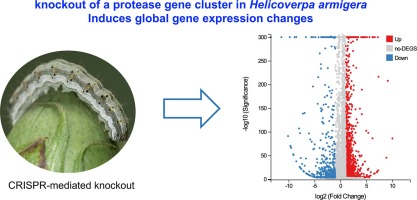当前位置:
X-MOL 学术
›
J. Insect Physiol.
›
论文详情
Our official English website, www.x-mol.net, welcomes your
feedback! (Note: you will need to create a separate account there.)
Global gene expression changes induced by knockout of a protease gene cluster in Helicoverpa armigera with CRISPR/Cas9.
Journal of Insect Physiology ( IF 2.3 ) Pub Date : 2020-02-20 , DOI: 10.1016/j.jinsphys.2020.104023 Meng Wang 1 , Shuangshuang Zhang 1 , Yu Shi 1 , Yihua Yang 1 , Yidong Wu 1
Journal of Insect Physiology ( IF 2.3 ) Pub Date : 2020-02-20 , DOI: 10.1016/j.jinsphys.2020.104023 Meng Wang 1 , Shuangshuang Zhang 1 , Yu Shi 1 , Yihua Yang 1 , Yidong Wu 1
Affiliation

|
Helicoverpa armigera is one of the most serious agricultural insect pests of global importance. It is highly polyphagous and depends on digestive serine proteases to degrade proteins to peptides and to amino acids. H. armigera has evolved adaptive ability to compensate for the inhibition of plant defensive protease inhibitors (PIs) in its diet by overproduction of digestive enzymes. As far as we know, compensation for deletion of serine protease genes has not yet been studied in any herbivorous insect. In this study, we used CRISPR/Cas9 to knock out a cluster of 18 trypsin-like genes in H. armigera. Compared with the wild type SCD strain, activities of the total proteases, trypsins and chymotrypsins were not significantly changed in the gene cluster knockout strain (Tryp-KO). RNA-seq data showed 1492 upregulated and 461 downregulated DEGs in Try-KO. GO function classification and KEGG pathway analyses revealed these differentially expressed genes were enriched for terms related to binding, catalytic activity, metabolic process and signal transduction. In regard to serine protease genes, 35 were upregulated and 12 downregulated in Tryp-KO strain. Our study indicated that H. armigera can compensate for the deleted protease genes by overexpression of other trypsin and chymotrypsin genes in order to maintain its genetic and metabolic robustness. It also suggests that genetic perturbations created by genome editing tools can induce global gene expression changes.
中文翻译:

CRISPR / Cas9敲除棉铃虫中蛋白酶基因簇诱导的全局基因表达变化。
棉铃虫是最重要的全球性农业害虫之一。它是高度多食性的,并且依赖于消化性丝氨酸蛋白酶将蛋白质降解为肽和氨基酸。棉铃虫已进化出适应能力,可通过消化酶的过量生产来补偿其饮食中对植物防御性蛋白酶抑制剂(PIs)的抑制作用。据我们所知,尚未在任何草食性昆虫中研究丝氨酸蛋白酶基因缺失的补偿。在这项研究中,我们使用CRISPR / Cas9敲除了棉铃虫中18个胰蛋白酶样基因的簇。与野生型SCD菌株相比,基因簇敲除菌株(Tryp-KO)中总蛋白酶,胰蛋白酶和胰凝乳蛋白酶的活性没有显着变化。RNA-seq数据显示Try-KO中有1492个上调的DEG和461个下调的DEG。GO功能分类和KEGG通路分析表明,这些差异表达的基因丰富了与结合,催化活性,代谢过程和信号转导有关的术语。关于丝氨酸蛋白酶基因,在Tryp-KO菌株中上调了35个,下调了12个。我们的研究表明,棉铃虫可以通过其他胰蛋白酶和胰凝乳蛋白酶基因的过表达来补偿缺失的蛋白酶基因,以保持其遗传和代谢稳健性。这也表明,由基因组编辑工具产生的遗传扰动可以诱导整体基因表达变化。代谢过程和信号转导。关于丝氨酸蛋白酶基因,在Tryp-KO菌株中上调了35个,下调了12个。我们的研究表明,棉铃虫可以通过其他胰蛋白酶和胰凝乳蛋白酶基因的过表达来补偿缺失的蛋白酶基因,以保持其遗传和代谢稳健性。这也表明由基因组编辑工具产生的遗传扰动可以诱导整体基因表达变化。代谢过程和信号转导。关于丝氨酸蛋白酶基因,在Tryp-KO菌株中上调了35个,下调了12个。我们的研究表明,棉铃虫可以通过其他胰蛋白酶和胰凝乳蛋白酶基因的过表达来补偿缺失的蛋白酶基因,以保持其遗传和代谢稳健性。这也表明由基因组编辑工具产生的遗传扰动可以诱导整体基因表达变化。
更新日期:2020-03-20
中文翻译:

CRISPR / Cas9敲除棉铃虫中蛋白酶基因簇诱导的全局基因表达变化。
棉铃虫是最重要的全球性农业害虫之一。它是高度多食性的,并且依赖于消化性丝氨酸蛋白酶将蛋白质降解为肽和氨基酸。棉铃虫已进化出适应能力,可通过消化酶的过量生产来补偿其饮食中对植物防御性蛋白酶抑制剂(PIs)的抑制作用。据我们所知,尚未在任何草食性昆虫中研究丝氨酸蛋白酶基因缺失的补偿。在这项研究中,我们使用CRISPR / Cas9敲除了棉铃虫中18个胰蛋白酶样基因的簇。与野生型SCD菌株相比,基因簇敲除菌株(Tryp-KO)中总蛋白酶,胰蛋白酶和胰凝乳蛋白酶的活性没有显着变化。RNA-seq数据显示Try-KO中有1492个上调的DEG和461个下调的DEG。GO功能分类和KEGG通路分析表明,这些差异表达的基因丰富了与结合,催化活性,代谢过程和信号转导有关的术语。关于丝氨酸蛋白酶基因,在Tryp-KO菌株中上调了35个,下调了12个。我们的研究表明,棉铃虫可以通过其他胰蛋白酶和胰凝乳蛋白酶基因的过表达来补偿缺失的蛋白酶基因,以保持其遗传和代谢稳健性。这也表明,由基因组编辑工具产生的遗传扰动可以诱导整体基因表达变化。代谢过程和信号转导。关于丝氨酸蛋白酶基因,在Tryp-KO菌株中上调了35个,下调了12个。我们的研究表明,棉铃虫可以通过其他胰蛋白酶和胰凝乳蛋白酶基因的过表达来补偿缺失的蛋白酶基因,以保持其遗传和代谢稳健性。这也表明由基因组编辑工具产生的遗传扰动可以诱导整体基因表达变化。代谢过程和信号转导。关于丝氨酸蛋白酶基因,在Tryp-KO菌株中上调了35个,下调了12个。我们的研究表明,棉铃虫可以通过其他胰蛋白酶和胰凝乳蛋白酶基因的过表达来补偿缺失的蛋白酶基因,以保持其遗传和代谢稳健性。这也表明由基因组编辑工具产生的遗传扰动可以诱导整体基因表达变化。











































 京公网安备 11010802027423号
京公网安备 11010802027423号